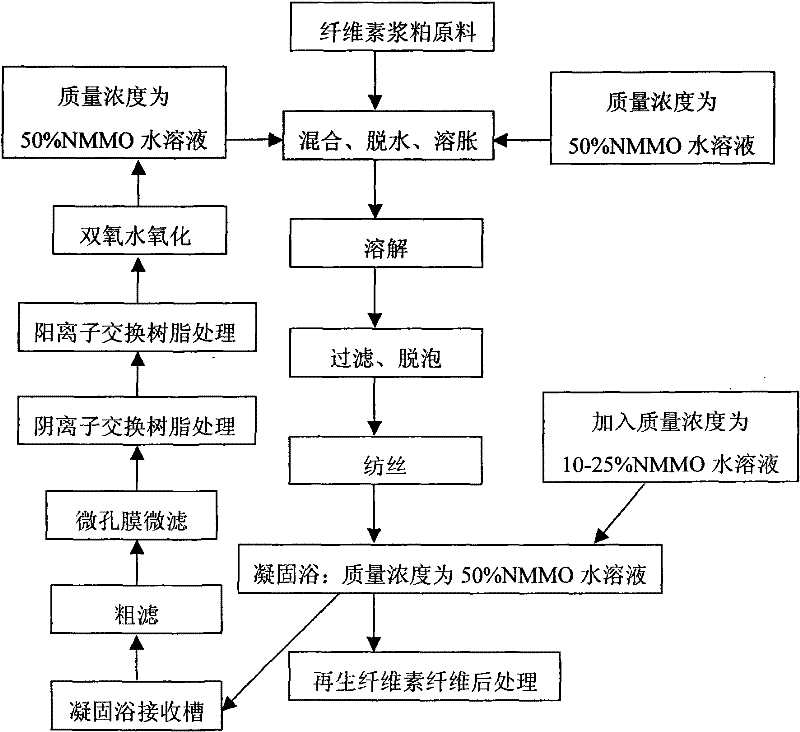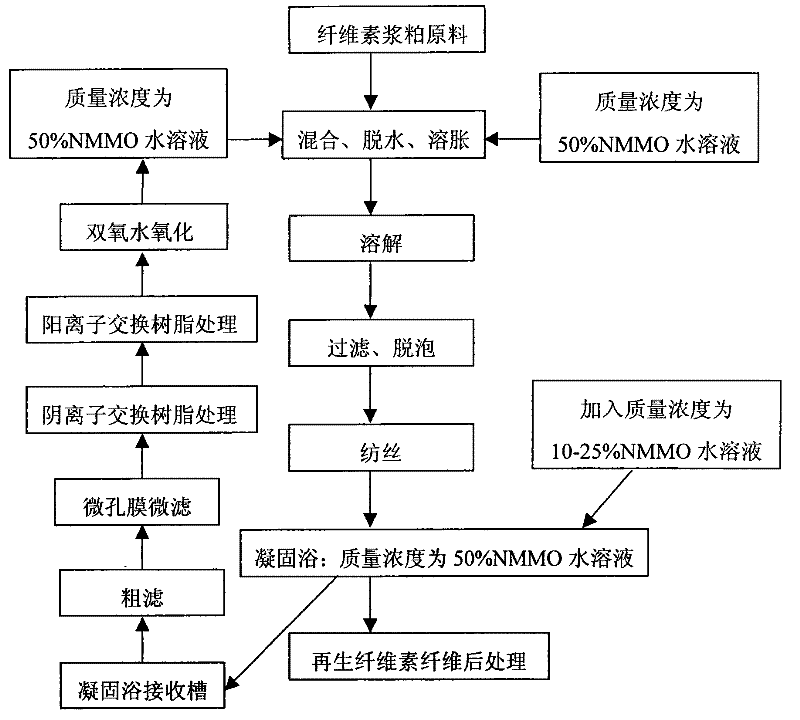Recovery method of N-methylmorpholine oxide solvent in process of producing regenerated cellulose fibre by solvent method
A technology of regenerated cellulose and methylmorpholine, which is applied in the fields of fiber chemical characteristics, rayon recycling, and final product manufacturing. It can solve the problems of increased production cost of regenerated cellulose fibers, large investment in evaporation and concentration equipment, and difficulty in industrial promotion, etc. problem, to achieve the effect of prolonging life, convenient operation and less production investment
- Summary
- Abstract
- Description
- Claims
- Application Information
AI Technical Summary
Problems solved by technology
Method used
Image
Examples
Embodiment 1
[0024] See figure 1 .
[0025](1) In the spinning process production of the regenerated reed fiber prepared by the solvent method, the NMMO aqueous solution with a commercially available mass concentration of 50% is used as a solvent to indirectly dissolve the reed pulp (polymer 302, the mass content of α-cellulose is 95.6%) ) preparing regenerated reed fibers; using an NMMO aqueous solution with a mass concentration of 50% as a coagulation bath for the regenerated reed fibers;
[0026] (2) Along with the carrying out of spinning process, add the NMMO aqueous solution that mass concentration is 25% in the coagulation bath of step (1) with the flow velocity of 340kg / h, make containing mass concentration be 50% with the flow velocity of 570kg / h simultaneously The NMMO aqueous solution discharges the container of loading coagulation bath in the receiving tank, under making the NMMO aqueous solution coagulation bath effectively circulates, the mass concentration of the NMMO aqueo...
Embodiment 2
[0033] (1) In the spinning process production of the regenerated bamboo fiber prepared by the solvent method, the NMMO aqueous solution of 50% is the solvent indirect dissolution of the bamboo pulp (the degree of polymerization is 773, the mass content of α-cellulose is 93.2% with the commercially available mass concentration). %) to prepare regenerated bamboo fiber; be the coagulation bath of regenerated bamboo fiber with the NMMO aqueous solution of 50% in mass concentration;
[0034] (2) Along with the carrying out of spinning process, add the NMMO aqueous solution that mass concentration is 10% in the coagulation bath of step (1) with the flow velocity of 0.54kg / h, make containing mass concentration be with the flow velocity of 1.11kg / h simultaneously 50% NMMO aqueous solution discharges the container of loading coagulation bath to receiving tank, under making NMMO aqueous solution coagulation bath effectively circulates, the mass concentration of the NMMO aqueous solution ...
Embodiment 3
[0041] (1) In the spinning process production of the regenerated cotton fiber prepared by the solvent method, the NMMO aqueous solution with a commercially available mass concentration of 50% is used as a solvent to indirectly dissolve the cotton pulp (the degree of polymerization is 1193, and the mass content of α-cellulose is 98.1 %) to prepare regenerated cotton fibers; the NMMO aqueous solution with a mass concentration of 50% is a coagulation bath for regenerated cotton fibers;
[0042] (2) Along with the carrying out of spinning process, add the NMMO aqueous solution that mass concentration is 15% in the coagulation bath of step (1) with the flow velocity of 121kg / h, make containing mass concentration be 50% with the flow velocity of 236kg / h simultaneously The NMMO aqueous solution discharges the container of loading coagulation bath in the receiving tank, under making the NMMO aqueous solution coagulation bath effectively circulates, the mass concentration of the NMMO aq...
PUM
| Property | Measurement | Unit |
|---|---|---|
| particle diameter | aaaaa | aaaaa |
| pore size | aaaaa | aaaaa |
| particle size | aaaaa | aaaaa |
Abstract
Description
Claims
Application Information
 Login to View More
Login to View More - R&D
- Intellectual Property
- Life Sciences
- Materials
- Tech Scout
- Unparalleled Data Quality
- Higher Quality Content
- 60% Fewer Hallucinations
Browse by: Latest US Patents, China's latest patents, Technical Efficacy Thesaurus, Application Domain, Technology Topic, Popular Technical Reports.
© 2025 PatSnap. All rights reserved.Legal|Privacy policy|Modern Slavery Act Transparency Statement|Sitemap|About US| Contact US: help@patsnap.com


